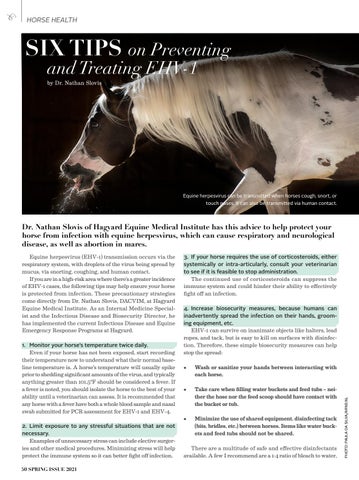HORSE HEALTH
SIX TIPS on Preventing
and Treating EHV-1 by Dr. Nathan Slovis
Equine herpesvirus can be transmitted when horses cough, snort, or touch noses. It can also be transmitted via human contact.
Dr. Nathan Slovis of Hagyard Equine Medical Institute has this advice to help protect your horse from infection with equine herpesvirus, which can cause respiratory and neurological disease, as well as abortion in mares.
1. Monitor your horse’s temperature twice daily. Even if your horse has not been exposed, start recording their temperature now to understand what their normal baseline temperature is. A horse’s temperature will usually spike prior to shedding significant amounts of the virus, and typically anything greater than 101.5°F should be considered a fever. If a fever is noted, you should isolate the horse to the best of your ability until a veterinarian can assess. It is recommended that any horse with a fever have both a whole blood sample and nasal swab submitted for PCR assessment for EHV-1 and EHV-4. 2. Limit exposure to any stressful situations that are not necessary. Examples of unnecessary stress can include elective surgeries and other medical procedures. Minimizing stress will help protect the immune system so it can better fight off infection. 50 SPRING ISSUE 2021
3. If your horse requires the use of corticosteroids, either systemically or intra-articularly, consult your veterinarian to see if it is feasible to stop administration. The continued use of corticosteroids can suppress the immune system and could hinder their ability to effectively fight off an infection. 4. Increase biosecurity measures, because humans can inadvertently spread the infection on their hands, grooming equipment, etc. EHV-1 can survive on inanimate objects like halters, lead ropes, and tack, but is easy to kill on surfaces with disinfection. Therefore, these simple biosecurity measures can help stop the spread: •
Wash or sanitize your hands between interacting with each horse.
•
Take care when filling water buckets and feed tubs – neither the hose nor the feed scoop should have contact with the bucket or tub.
•
Minimize the use of shared equipment, disinfecting tack (bits, bridles, etc.) between horses. Items like water buckets and feed tubs should not be shared.
There are a multitude of safe and effective disinfectants available. A few I recommend are a 1:4 ratio of bleach to water,
PHOTO: PAULA DA SILVA/ARND.NL
Equine herpesvirus (EHV-1) transmission occurs via the respiratory system, with droplets of the virus being spread by mucus, via snorting, coughing, and human contact. If you are in a high-risk area where there’s a greater incidence of EHV-1 cases, the following tips may help ensure your horse is protected from infection. These precautionary strategies come directly from Dr. Nathan Slovis, DACVIM, at Hagyard Equine Medical Institute. As an Internal Medicine Specialist and the Infectious Disease and Biosecurity Director, he has implemented the current Infectious Disease and Equine Emergency Response Programs at Hagyard.
